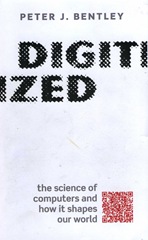THE GENERALIST has been completely absorbed over the last couple of weeks with this new history of computers – a subject on which I have previous form. We knew about Turing in the 1970s. In the 1980s I worked on a book on computer graphics. In the 1990s I wrote an extensive 12pp piece on the upcoming digital revolution for The Telegraph magazine (1994), set up a web company and researched and wrote a lengthy chronology on ‘The History of Communications: 1749-2001’ for the Arthur C. Clarke website we created, funded by Cable & Wireless. As a result, THE GENERALIST Archive holds an extensive collection of books, magazines, images, videos and ephemera on communications and computing which, as a result of reading this book, I am now cataloguing.
*
‘Digitized’ is a great introductory broad-brushstroke history, from the 1930s to the present day, of the computer science revolution that has fundamentally changed a wide variety of other scientific disciplines and affected every aspect of our daily lives.
Peter J. Bentley writes; ‘Computer processors and software represent the most complex designs humans have ever created. The science of computers has enabled one of the most extraordinary transformation of our societies in human history.’
The book covers the development of the computer hardware and software, the theories and concepts that lay behind them, and the lives, careers, and thoughts of the pioneering scientists. It documents the birth and growth of the Internet, artificial intelligence (AI) and computer graphics, and charts developments in medical imaging, genetic algorithms, robotics and many other fields and applications.
For me the real revelations were the life and achievements of Claude Shannon – the father of communications, information theory and cryptography – and those of two British pioneers who I was previously unaware of Maurice Wilkes (the father of British computing, both in hardware and software, who died at the age of 97 in 2010) and Peter Kerstein, who played a significant technical and political role in making the Internet a network of networks (and is still working at the Dept of Computer Science at UCL in London).
The author has created a strong narrative that skilfully interweaves pen portraits, technological milestones and key ideas - presented first in a technical/scientific form and then explained using simply expressed metaphoric models understandable by a general reader.
The result is a satisfying and invigorating book, packed with intriguing facts and brain-stirring concepts. It provides a holistic picture of the origins of our digitally connected world. An exciting story, well told.
Digitized by Peter J. Bentley is published by Oxford University Press.
[According to his author-provided bio on Amazon: Dr. Bentley is a maverick computer scientist known for his creative thinking and high-impact research. For over a decade he has funded his research at UCL through writing popular science books. He also accidentally had a number one best selling iPhone app.]
Another popular history of computer science, authored by Ian Watson, is being published by Springer this year. You can read all about it on his blog site: http://universal-machine. blogspot.co.nz/
The lead story on the blog at present is: ‘I’m Getting A Bionic Hand.’
‘I've been keeping this a big secret because it's fairly awesome. I research in artificial intelligence and robotics and have had a research project in development for a while now. It involves replacing my right hand with a robotic bionic hand. Needless to say I've had quite a mission getting this past Auckland University's Human Participants Ethics Committee. They were totally against it for months, but eventually realized that the only way I could develop the capabilities of the robotic hand and its neuro-computing control link was by replacing my own hand, given that I couldn't find any other willing volunteer locally.’



No comments:
Post a Comment